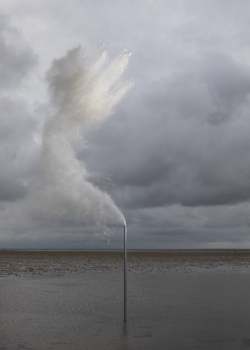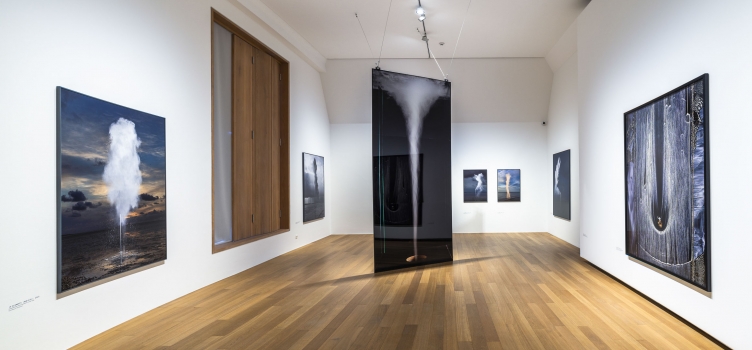In Sweden, a series of tests from the field of solar geoengineering, which deals with methods for cooling the planet Earth, was recently stopped. The incident shows how close the Dutch photo artist Sjoerd Knibbeler works to the pulse of time. It is about globally virulent issues that affect the survival of our planet Earth.
Under the title "Sjoerd Knibbeler. In Elements," the Museum Kunst der Westküste dedicates to the 1981-born Dutch photo artist his first solo museum exhibition in Germany. Until January 16, 2022, a comprehensive selection of artworks by the artist will be presented, who programmatically works at the interface of natural science, technology, and art. Knibbeler's photographs are aesthetically extremely appealing, and at the same time, their unconventional motifs make us as viewers extremely curious. Because what exactly do they actually show?

Sjoerd Knibbeler, In Elements (SSE-W), 2020
Basically: Knibbeler is intensely interested in nature. He does not take a pictorial approach but instead photographs precisely what is not usually seen: Things and phenomena that are invisible, like the air, or speedy, like a meteorite. Possibly the artist also captures that which factually does not even exist - because he is interested in how something might look. The latter also applies to his photographic works "In Elements," which were created in the summer of 2020 during his stay as an artist in residence on the island of Föhr. In the parts up to life-size artworks, the foreign body of a narrow, shiny silver metal tube regularly looms in the Wadden Sea, from which a powerful "cloud fountain" rises toward the sky. Still, in the moment of the photographic shot, it is captured by the wind and carried away.
The series of motifs provides an unusual occasion to show the beauty of the Wadden Sea with its diverse plays of color and light. And yet, the " images " evoke, due to the technoid-looking "explosions" and the artificial arrangement staged by the artist, also a diffuse sense of threat - of the habitat essential for survival.
For his photo series "In Elements", Sjoerd Knibbeler has looked at technical possibilities that could respond to the increasing warming of our planet. More specifically, the artist has been inspired by the science of so-called stratospheric aerosol injection (SAI). This technology involves, among other things, injecting calcium carbonate into the stratosphere, the second layer of the Earth's atmosphere. There, the aerosols are supposed to scatter sunlight, preventing it in part from acting in destructive ways on our planet's habitats.
Knibbeler has recreated this in his series of experiments in the Föhr mudflats on a greatly reduced scale using simple means in a very impressive way.

Before the arrival of Knibbeler's assistant, Yentl van Toledo, the author helps the artist set up the experiment in the mudflats.
Up to now, such drastic interventions into the natural cycle as that of SAI have only been discussed theoretically in the scientific community. The discussion about the effectiveness among scientists is controversial due to possible risks. As a recently published article from the scientific journal "MIT Technology Review" shows, this is a topic that no longer is or should be confined to scientific circles.
The article is available online at:
What is the essential point of the article? At Esrange Space Center in Kiruna, Sweden, a balloon was recently scheduled to go up. It was to carry equipment for future experiments in solar geoengineering into the stratosphere for testing purposes. So it was about a trial in advance of the actual experiment to better understand the potential and risks of such technologies. Along was David Keith, professor of applied physics at Harvard University and a leading figure in the field of climate research.
However, the company in Sweden was stopped by a Harvard University committee. The committee, established in 2019, is tasked with reviewing experiments like these, including ethical aspects. The aim is to involve the public, provide information, and respond to concerns expressed, for there are a number of them, especially concerning the as yet hardly foreseeable climatological and biological consequences of such interventions. The fear is also that the technology could be used as a political free ride: It might seem unnecessary to continue to restrain energy consumption or reduce carbon emissions if global warming can be virtually reversed.
Sjoerd Knibbeler is, of course, aware of these objections. Personally, he hopes that SAI will never have to be utilized. As an artist, however, he takes the freedom to work precisely on this, to experiment, to create images of the future, and to create a public sphere.
The Dutchman appreciates transparent facts, expert analysis, and the available weighing of pros and cons. Polarizing debates are not his thing. His artistic work opens up opportunities for him to get a "grip" on complex issues. We, in turn, can simply like his photographs. Alternatively, they may arouse our curiosity and even encourage us to form our own opinion - about a subject that concerns us all.
Sjoerd Knibbeler spoke with David Keith and interviewed the scientist as part of the preparations for his photographic work "In Elements", which was created on Föhr. The interview can be found in the exhibition catalog of the same name. The catalog is available for 34 € in the MKdW store.
You can visit the exhibition "Sjoerd Knibbeler. In Elements" also online on our virtual tour. It is located in room 5: MKdW-3.

Exhibition: "Sjoerd Knibbler. In Elements", photo: Lukas Spörl
Dr. Pia Littmann is a MKdW Scientific Exhibition Coordinator and with the artist Sjoerd Knibbeler, curator of the exhibition "In Elements
